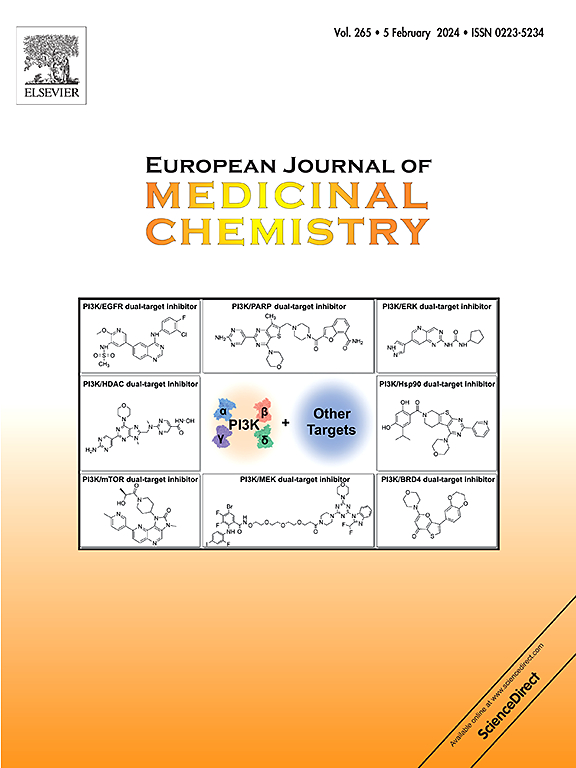通过ATF3/SLC7A11/GPX4途径抑制铁下垂的潜在抗缺血性卒中药物的发现
IF 6
2区 医学
Q1 CHEMISTRY, MEDICINAL
引用次数: 0
摘要
缺血性中风是全世界发病率和死亡率的主要原因。尽管其影响广泛,但有效的治疗方法仍然有限。依地苯酮(IDE)已显示出促进中风后恢复的希望;然而,其在缺血性脑卒中急性期的疗效仍不理想。因此,开发新型IDE类似物对于改善缺血性卒中治疗的结果具有重要意义。在此,我们设计并合成了一系列新的IDE类似物(1a-1g)。采用氧-葡萄糖剥夺/再氧合(O/R)细胞模型和大脑中动脉闭塞(MCAO)动物模型,分别在体外和体内观察这些药物的作用。由于其强大的神经保护作用,1c被认为是最有希望的候选者。实验分析表明,1c治疗可减少缺血性损伤后的梗死面积,提高神经元存活率。1c通过抑制铁下垂进一步减轻缺血/再灌注(I/R)损伤后的神经退行性变。此外,我们的研究结果显示,激活转录因子3 (ATF3)的表达在I/R损伤后上调,但在1c治疗后明显抑制。ATF3过表达下调了铁下垂的关键调控因子SLC7A11和GPX4的表达,从而促进了I/R损伤后的铁下垂。总的来说,我们的研究结果强调了1c在缺血性卒中中的治疗潜力,并为其神经保护作用的潜在机制提供了见解。本文章由计算机程序翻译,如有差异,请以英文原文为准。


Discovery of a potential anti-ischemic stroke agent by suppressing ferroptosis through the ATF3/SLC7A11/GPX4 pathway
Ischemic stroke is a leading cause of morbidity and mortality worldwide. Despite its widespread impact, effective treatments remain limited. Idebenone (IDE) has shown promise in promoting recovery following stroke; however, its efficacy during the acute phase of ischemic stroke remains suboptimal. Therefore, the development of novel IDE analogs is of significant importance for improving outcomes in ischemic stroke treatment. Herein, we designed and synthesized a series of novel IDE analogs (1a–1g). An oxygen-glucose deprivation/reoxygenation (O/R) cell model and middle cerebral artery occlusion (MCAO) animal model were employed to investigate the effects of these drugs in vitro and in vivo, respectively. 1c was identified as the most promising candidate owing to its potent neuroprotective effects. Experimental analyses demonstrated that treatment with 1c reduced infarct size following ischemic injury and enhanced neuronal survival. 1c further alleviated neurodegeneration following ischemia/reperfusion (I/R) injury by inhibiting ferroptosis. Furthermore, our findings revealed that the expression of activating transcription factor 3 (ATF3) was upregulated after I/R injury, but markedly suppressed upon treatment with 1c. ATF3 overexpression downregulates the expression of SLC7A11 and GPX4, which are critical regulators of ferroptosis, thereby facilitating ferroptosis following I/R injury. Overall, our findings highlight the therapeutic potential of 1c in ischemic stroke and provide insight into the underlying mechanisms of its neuroprotective effects.
求助全文
通过发布文献求助,成功后即可免费获取论文全文。
去求助
来源期刊
CiteScore
11.70
自引率
9.00%
发文量
863
审稿时长
29 days
期刊介绍:
The European Journal of Medicinal Chemistry is a global journal that publishes studies on all aspects of medicinal chemistry. It provides a medium for publication of original papers and also welcomes critical review papers.
A typical paper would report on the organic synthesis, characterization and pharmacological evaluation of compounds. Other topics of interest are drug design, QSAR, molecular modeling, drug-receptor interactions, molecular aspects of drug metabolism, prodrug synthesis and drug targeting. The journal expects manuscripts to present the rational for a study, provide insight into the design of compounds or understanding of mechanism, or clarify the targets.

 求助内容:
求助内容: 应助结果提醒方式:
应助结果提醒方式:


